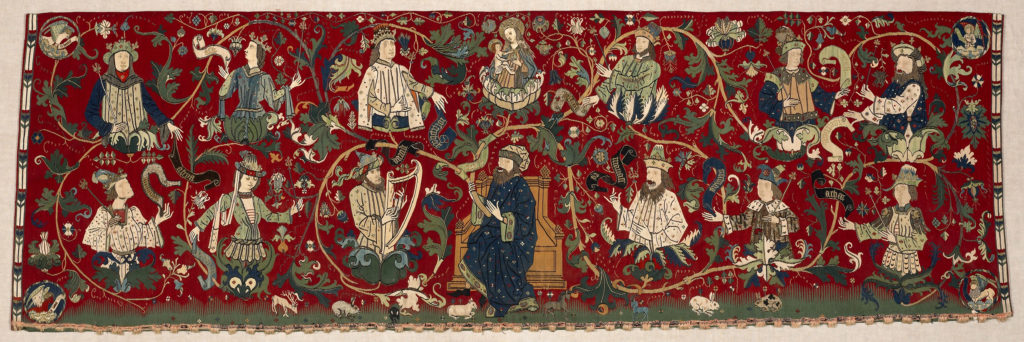Jesse’s seated repose signals that he is receiving a vision from God. King David, his son, shown playing his harp, is on Jesse’s right and the succession of kings proceeds in a clockwise direction to Manasses on Jesse’s left. The Tree of Jesse became a popular subject in the Middle Ages, since its focus on Christ’s human ancestry registered a renewed emphasis on Christ’s Incarnation in religious worship, and more attention to the human condition in intellectual thought and in society more generally. By the fourteenth and fifteenth centuries, the kings in Trees of Jesse had become lively participators in Isaiah’s prophecy, whilst the ‘trees’ delighted with a range of floral and foliate designs incorporated into their vine-like structures and inhabitation by birds and small animals.
The inclusivity of Christianity is shown by the interaction of the kings, gesturing to the holy mother and son, to Jesse or to each other in a grand animated dialogue. The distance of time and geography between the ancient kings of the Holy Land and the medieval Rhineland viewers of the altar frontal is bridged by dressing the kings in fashionable later-fifteenth-century German clothes. The variety and detail of the clothing has been made possible by the expert use of at least nine different thread types, including dyed wools, dyed silks, silver, silver alloys and gilded gut. The humanity of the kings is enhanced by the sensitive modelling of facial features in paint. The rabbits and small animals on the grass at the bottom of the textile added to the naturalistic appeal of the ensemble, whilst carrying their own spiritual meanings (rabbits were associated with the Virgin, and with rebirth and the Resurrection). The Christian message of the prophecy is also framed by the familiar symbols of the four gospel authors at the corners of the textile.
The church for which the altar frontal was made is not known, but border panels that are now detached may offer clues about its early viewers. A shallow border at the top included images of Saint Catherine of Alexandria and Saint Barbara who were frequently found together in fifteenth-century works from the Rhineland, adding to the evidence of the textile’s production and use in that region in the late Middle Ages. Side panels that have the same curling vine design of the frontal made significant use of embroidery, as well as appliqued figures not used in the altar frontal, were probably produced somewhat later. The vines on these panels encircle representations of Christ, angels, a bishop and nuns. The inclusion of the nuns, who wear brown tunics and black veils, suggest that the altar frontal and border panels may have been produced and/or used in a convent. Production of similar textiles within religious communities is known. For example, the Victoria and Albert Museum in London owns a rectangular panel thought to have been woven in a Rhineland convent around 1490, which shows a woman on a quest for truth that ends with her entering a convent (http://collections .vam.ac.uk/item/O17862/the-search-after-truth-tapestry-panel-unknown/).
Anne Kirkham, University of Manchester
